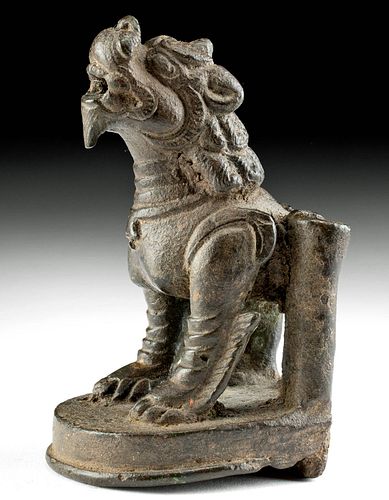17th C. Nepalese Brass Foo Dog
Lot 66b
About Seller
Artemis Gallery
686 S Taylor Ave, Ste 106
Louisville, CO 80027
United States
Selling antiquities, ancient and ethnographic art online since 1993, Artemis Gallery specializes in Classical Antiquities (Egyptian, Greek, Roman, Near Eastern), Asian, Pre-Columbian, African / Tribal / Oceanographic art. Our extensive inventory includes pottery, stone, metal, wood, glass and textil...Read more
Categories
Estimate:
$800 - $1,200
Absentee vs Live bid
Two ways to bid:
- Leave a max absentee bid and the platform will bid on your behalf up to your maximum bid during the live auction.
- Bid live during the auction and your bids will be submitted real-time to the auctioneer.
Bid Increments
| Price | Bid Increment |
|---|---|
| $0 | $25 |
| $300 | $50 |
| $1,000 | $100 |
| $2,000 | $250 |
| $5,000 | $500 |
| $10,000 | $1,000 |
| $20,000 | $2,500 |
| $50,000 | $5,000 |
| $100,000 | $10,000 |
| $200,000 | $20,000 |
About Auction
By Artemis Gallery
Oct 22, 2020
Set Reminder
2020-10-22 10:00:00
2020-10-22 10:00:00
America/New_York
Bidsquare
Bidsquare : Ancient & Ethnographic Art Through The Ages
https://www.bidsquare.com/auctions/artemis-gallery/ancient-ethnographic-art-through-the-ages-5850
Ancient art from Egypt, Greece, Italy and the Near East, as well as Asian, Fossils, Pre-Columbian, Native American, African / Tribal / Oceanic, Fine art, and much more! All categories, all price ranges... all legally acquired and guaranteed to be as described or your money back. Artemis Gallery info@artemisgallery.com
Ancient art from Egypt, Greece, Italy and the Near East, as well as Asian, Fossils, Pre-Columbian, Native American, African / Tribal / Oceanic, Fine art, and much more! All categories, all price ranges... all legally acquired and guaranteed to be as described or your money back. Artemis Gallery info@artemisgallery.com
- Lot Description
Asia, Nepal, 17th to 18th century. A brass bust of a Buddhist lion or Foo Dog (also "fu" dog) presenting a fierce expression with glaring eyes, flaring nostrils, and open toothy mouth. Its body is meticulously rendered with a curly mane and a decorative collar that is particularly delightful; take note of the little bell. Foo Dogs are usually presented in pairs outside of a palace, temple, government ofices, or tomb to protect those within, representing the male and female as well as yin and yang. Symbolically, the male protects the outside, and the female protects the inside of the dwelling. Initially featured in Chinese palaces and tombs, Foo Dogs became popular in other parts of Asia such as Japan, Korea, Tibet, Thailand, Burma, Vietnam, Sri Lanka, Cambodia, Laos, Taiwan, Singapore, and Nepal. Size: 2.1" W x 3.6" H (5.3 cm x 9.1 cm)
The "foo dog" is a western name for the Chinese "shi shi", the guardian lion, who since the Han Dynasty has stood in statue form protecting Imperial palaces, tombs, temples, and government offices. The Fu Dog is actually a guardian lion, a common architectural protective figure in Imperial China that was originally brought to Indian culture alongside Buddhism.
Provenance: private New Jersey, USA collection
All items legal to buy/sell under U.S. Statute covering cultural patrimony Code 2600, CHAPTER 14, and are guaranteed to be as described or your money back.
A Certificate of Authenticity will accompany all winning bids.
We ship worldwide and handle all shipping in-house for your convenience.
#156522Slight bending to form. Possible area of repair on a back interior area but if so it is well done and very difficult to see - more likely a casting flaw. The animal is beautifully preserved with a rich, dark patina.Condition
- Shipping Info
-
All shipping is handled in-house for your convenience. Your invoice from Artemis Gallery will include shipping calculation instructions. If in doubt, please inquire BEFORE bidding for estimated shipping costs for individual items.
-
- Buyer's Premium



 EUR
EUR CAD
CAD AUD
AUD GBP
GBP MXN
MXN HKD
HKD CNY
CNY MYR
MYR SEK
SEK SGD
SGD CHF
CHF THB
THB















